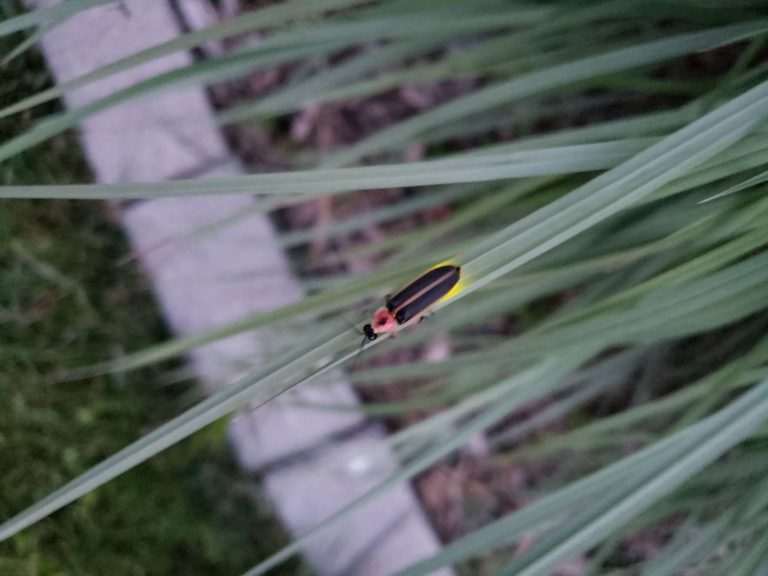Native spotlight: Protecting a summer lit night
Start a discussion about lightning bugs and you are bound to hear someone say, “I used to see more of them,” an accurate observation since fireflies are declining worldwide. As we begin thinking about the autumn garden chores, it’s a good time to consider steps that can be taken right now to help conserve firefly populations.
Fireflies, also called lightning bugs, are beetles and there are about 2,000 species throughout the world! We are fortunate to live east of the Rockies as although the west has fireflies, their adults don’t glow. In the Mid Atlantic, there are at least one dozen species of these magical insects that make our summer nights so memorable. By taking immediate, simple actions, homeowners can help preserve these awe-inspiring beetles so that future generations can experience the magic of summer nights filled with their fairy-like glow.
Their light is all about love, used to find mates and reproduce. Although there are many species and not all act the same, for most it is the male flying around looking for love as the female stays close to the ground. If she likes his light show, she’ll flash back and wait for him to find her. Each species of firefly has a different flash pattern, with different time intervals between flashes in order to help

them find their own species. The color of light produced also varies by species, ranging from yellow to green or orange.
The life stage that enthralls us is the final or adult stage, which lasts for only a few days to two weeks as fireflies spend most of their lifetime-close to two years-at ground level or underground as larva. Therefore, their show needs to be appreciated while it lasts. They are also called glow worms because their larvae light up. In fact, even fireflies that don’t produce light as adults light up as larva crawling underground where they help the gardener by devouring slugs and worms.
Fireflies are habitat specific, just as plants are. Each species has a certain habitat it needs to thrive, just as most plants need specific soil requirements such as dry or wet. There are numerous reasons for their decline, and these are across-the-board occurrences that threaten insects and animals of many kinds. They include habitat loss, as open areas are converted to housing or commercial areas, use of pesticides, climate change and light pollution. Yes, keeping outdoor lights on at night disrupts the mating patterns of most firefly species as they use their own light to find each other. In fact, about one month ago, the state of Connecticut passed a law requiring state buildings to dim non-essential lights after 11pm in order to prevent the premature death of birds, especially those that migrate at night. Light pollution harms human health as well as wildlife. For more on this visit Dark Sky International.
So what can the average homeowner do?
- Reduce the size of your lawn and plant native grasses. These provide habitat for lightning bugs.
- Avoid disturbing the soil with practices such as digging, tilling, and compacting it through the use of machines. This is because fireflies spend the first two years of their lives underground and soil disturbance harms them. Therefore, mow less often and mow high. Naturally, we are gardeners and have plants to install, but keeping this fact in mind will help us make better decisions and avoid disturbing areas unnecessarily.
- Avoid the use of chemical fertilizers and pesticides as these kill not only fireflies, but the food they eat such as slugs and grubs, reducing their food supply.
- Don’t spray for mosquitos. These products may be advertised as “natural,” but they are still deadly, killing many insects in addition to the mosquitos that will just fly back into your yard. Here’s an alternative, a mosquito trap you can make.
- Turn off outdoor lights at night and where lights are needed for safety, use motion lights. This saves not only our wildlife but your electric bill as well.
- Leave the leaves. Leaf litter and the moisture it retains is critical to firefly survival as it provides shelter & moisture that attract what firefly larvae eat. In addition, many insects hide and lay eggs in leaf litter. Leaf removal, shredding, or bagging destroys not only fireflies but butterflies and other insects as well. One way to keep these materials in your garden is to leave a corner of your yard as a leaf and brush pile.
Learn more about fireflies, including the synchronous fireflies that coordinate to all flash at the same time, by watching this video, Fireflies in your garden. Help give future generations the opportunity to experience a summer night lit by fireflies. Turn off your lights so theirs can continue to glow.
Links:
Dark Sky International https://darksky.org/
mosquito trap https://www.audubonva.org/news/how-to-set-up-a-mosquito-larva-trap
Native Plant Channel firefly video https://youtu.be/GK85PHvF5Zk
